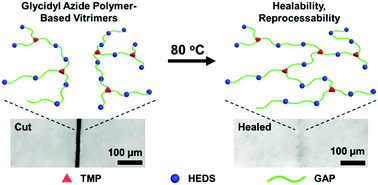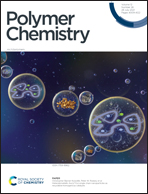Glycidyl azide polymer-based polyurethane vitrimers with disulfide chain extenders†
Abstract
The glycidyl azide polymer (GAP) is an important type of energetic polymer and is considered to be the most promising candidate for polymeric binders for next generation solid propellants. However, the most outstanding obstacle for the wide application of GAP is its low mechanical properties, which is usually overcome by incorporating it into polyurethanes (PUs) as a soft segment. Herein, we report the preparation of a series of GAP-based PU vitrimers (GAPUVs), with GAP, 2-hydroxyethyl disulfide (HEDS), and trimethylolpropane (TMP) as the soft segment, chain extender and crosslinker, respectively. The crosslinking density and composition of the resultant thermosetting GAPUVs were optimized to significantly improve the mechanical properties, which were clearly superior to their linear counterparts and most examples from the literature. More interestingly, the incorporation of dynamic disulfide bonds in the network not only endowed the GAPUVs with decent mechanical properties, but also marked healing ability upon mild heating and thermo-reprocessability. This allowed the fabrication of healable composites from GAPUVs and aluminum powders, with a healing efficiency above 95%. Additionally, the thermo-exchangeable disulfide linkage in the GAPUVs allowed the full recovery of the loaded fillers by simply heating the composite in a solvent.



 Please wait while we load your content...
Please wait while we load your content...